Using a Yastrzemski to Evaluate Home Run Rate

One of those great moments in baseball occurred on Tuesday, September 17, when the San Francisco Giants faced the Boston Red Sox at Fenway Park. Leading off and playing left field for the Giants was Mike Yastrzemski. That last name should sound familiar to most baseball fans and especially familiar to Red Sox fans. Mike’s grandfather is Carl Yastrzemski, one of the greatest players in Red Sox history. Carl played 23 years for the Red Sox from 1961 to 1983. He played at least one game in left field in 21 of those 23 seasons.
It must have been quite a thrill for Carl to see his grandson play in front of the Green Monster, just like he himself had done so many times before. The night became a little more magical when Mike Yastrzemski hit a home run to center field in the top of the fourth inning. The result of the game didn’t really matter because neither team is fighting for a playoff spot, but the Giants did win, 7-6, in 15 innings. The next day, Carl Yastrzemski threw out the first pitch to grandson Mike in front of a cheering crowd.
Baseball has been in the Yastrzemski blood for generations. Before Carl was born, his father, Carl Sr., formed a semipro baseball team that was made up of Yastrzemskis, including his four brothers, two brothers-in-law, and three cousins. Years later, Carl caught the attention of pro scouts when he played for a semipro team while still in high school. This was before the MLB draft was instituted. In those days, teams competed for the best amateur ballplayers and sent scouts out to sign them. Carl had offers from the Yankees and Red Sox, but chose to go to Notre Dame instead on a half baseball/half basketball scholarship.
After one year at Notre Dame, Carl signed with the Red Sox in November of 1958 for $108,000. He played one year in the low minors (Class B Carolina League) and one year in the high minors (Class AAA American Association) before reaching the major leagues for good in 1961 as a 21-year-old. All he had to do at that point was replace one of the greatest hitters who ever played the game, Ted Williams, who had retired after the 1960 season. Williams ended his career with a home run at Fenway Park, which inspired the John Updike line, “Gods do not answer letters.”
Carl Yastrzemski wasn’t Ted Williams, because no one is, but he was a terrific ballplayer. He was an 18-time all-star, the 1967 AL MVP and Triple Crown winner, and led the league in batting average three times, on-base percentage five times, and slugging percentage three times. He finished his career with 3419 hits, 452 homers, and a .285/.379/.462 batting line. He was elected to the Baseball Hall of Fame on his first ballot in 1989 (along with Johnny Bench).
In contrast to his grandfather, Mike Yastrzemski is a 28-year-old rookie who spent six seasons working his way up through the minor leagues after being drafted in the 14th round by the Baltimore Orioles in 2013. Including this year, Yastrzemski spent parts of four seasons in AAA, where he hit .251/.342/.442. He was never a highly-regarded prospect. The most home runs he ever hit in a season before 2019 was 15.
This year has been very different for Mike. He hit .316/.414/.676, with 12 homers in 40 games in AAA. Since joining the Giants on May 25, he’s launched 20 homers in 99 games, with a .267/.327/.513 batting line. At a glance, those are impressive numbers for any player and particularly impressive for a rookie.
Context matters, though, and it should affect how we perceive the two Yastrzemskis. The 2019 season is the year of the home run. Major League Baseball has never seen home runs fly over the wall at a greater rate than this season (likely due to changes in the ball). The Twins and Yankees have already broken the team single-season record for home runs and the Astros and Dodgers should pass that mark before the season is over. The Baltimore Orioles pitching staff has already shattered the record for home runs allowed in a season.
This chart shows the progression in home run rate since the Live Ball era began in 1920 (it should be noted that key components of what is referred to as the Live Ball era were the elimination of the spitball and that umpires started discarding baseballs that were scuffed up and discolored following the fatal beaning of Ray Chapman).

With 20 homers in 379 plate appearances, Mike has launched a home run 5.3 percent of the times he’s stepped to the plate. Grandpa Carl topped that rate just three times in his long career, in years in which he hit 44, 40, and 40 homers. The 44 homers came in his 1967 Triple Crown season and he hit 40 in back-to-back years in 1969 and 1970.
Let’s look at that 1969 season. Carl Yastrzemski hit 40 home runs in 707 plate appearances, which translates to a home run 5.7 percent of his times at the dish. That’s slightly higher than Mike’s 5.3 percent this season. The context is quite different, however. In 1969, MLB hitters launched home runs in 2.1 percent of their plate appearances. This year, as noted above, the rate is 3.6 percent.
Putting that all together, we find that in 1969, Carl Yastrzemski hit home runs 2.7 times as often as the average hitter. In 2019, Mike Yastrzemski has homered 1.5 times as often as the average hitter. Another way to think about it: in 1969, Carl’s 5.7 percent home rate ranked 11th among hitters with 350 or more plate appearances. In 2019, Mike’s 5.3 percent rate ranks 41st. Mike’s impressive numbers are strongly influenced by the time in which he plays.
Context matters so much in baseball. Knowledgeable baseball fans have been adjusting for context for years. We know about the Live Ball era that began in 1920 and the ridiculous level of offense in 1930, which is still the most prolific run-scoring season in baseball history. We know offense plummeted during World War II, had a resurgence in the 1950s, then plummeted again in the late-60s. The 1968 season is known as “The Year of the Pitcher” for a reason: it’s still the lowest-scoring season since 1920.
We know the 1987 season was a bizarre outlier for home runs, with a record-high HR/PA rate at the time of 2.8 percent. Guys who weren’t considered home run hitters, like Wade Boggs (24 HR) Juan Samuel (28 HR), and Dale Sveum (25 HR) had career highs. That season turned out to be a blip on the radar. The home run rate dropped back to 2.0 percent in 1988 and it would take another nine years before the home run rate reached the 1987 level again. This time, it stayed there for a while as baseball entered the Selig Era. From 1996 to 2006, the MLB home run rate was 2.8 percent.
During the decade or so after 2007, the home run rate stabilized around 2.6 percent until the most-recent four seasons, when it has been 3.0 percent or higher each year and all the way up to 3.6 percent this year. Mike Yastrzemski couldn’t have picked a better year to make his big league debut than 2019, “The Year of the Homer.”
This isn’t meant as a knock on Mike Yastrzemski. He’s having a fine year, especially for a rookie. His 1.9 WAR ranks 12th among the 30 rookie hitters with 300 or more plate appearances. His 117 wRC+ ranks 8th. He should be proud. Grandpa Carl should be proud. All of the past and future Yastrzemskis should be proud. But the context of this high-homer season should also be considered.
It will be interesting to see what happens next year. Is this the new normal or will the home run rate drop back to its previous level? Thirty years from now, will baseball fans think of 2019 as another outlier, like 1987, or part of a long run of homer-happy seasons, like the 1996 to 2006 stretch?












